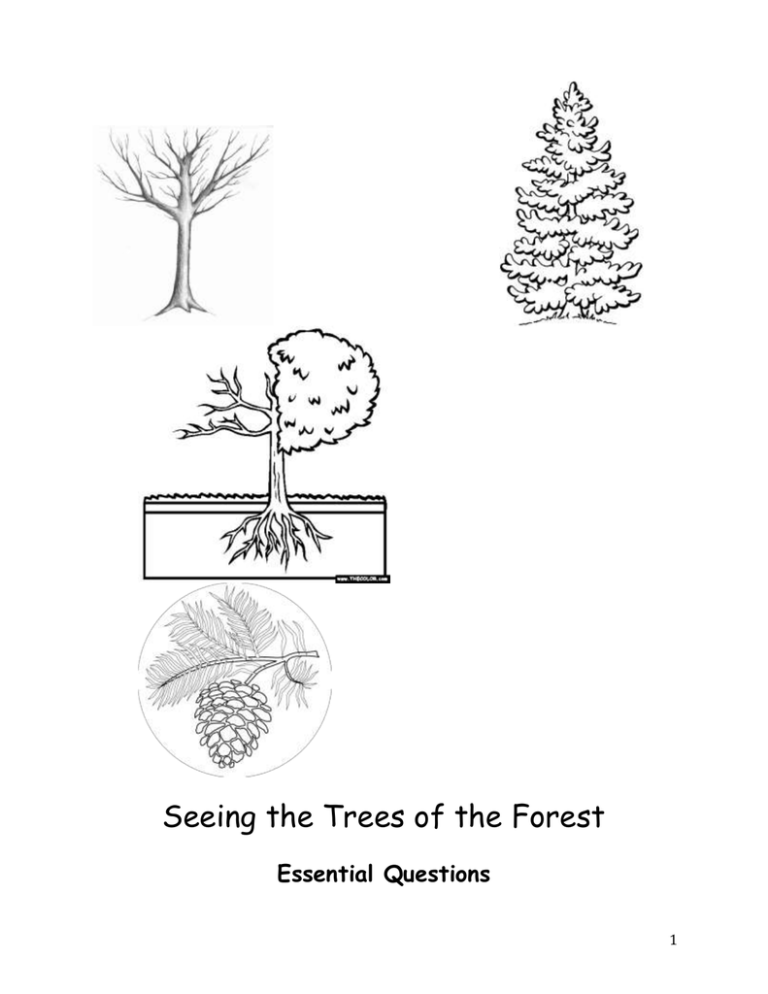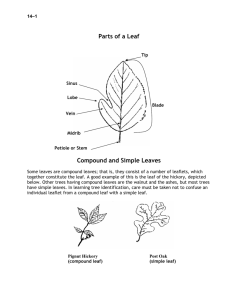LEAF COLLECTION GRADE Name
advertisement

Seeing the Trees of the Forest Essential Questions 1 What trees are common in Pennsylvania ? How can these trees be identified ? How do trees grow and reproduce ? Name _______________________________ Period _____________ 2 Types of Leaf Arrangement 3 BACKGROUND INFORMATION: SCIENTIFIC NAMES Scientific names are all written in Latin. This method of naming organisms is called binomial nomenclature. It was developed by an eighteenth century Swedish scientist Carolus Linnaeus. We will learn more about him later. These names provide a common language for scientists. This helps to reduce two problems. First, it allows scientists who speak different languages to communicate. Second it reduces confusion that arises when an organism has more than one common name. Tips for Writing Scientific Names 1. Each scientific name has two parts. They are the genus and species. Always write both of these. 2. The first name is the genus. Only the first letter of the genus should be capitalized. 3. The second name is the species. All letters in the species name should remain in lower case. 4. Both the genus and species names should be underlined if they are written by hand or typed in italics. 4 PRACTICE PROBLEMS Using a Common Trees of Pennsylvania book, write the scientific name for each of the following common names. 1. Black Walnut 2. Common Honeylocust 3. American Linden 4. Witch Hazel 5. Black Oak 6. Red Maple 7. Paper Birch 8. Black Cherry 9. Sycamore 10. Shagbark Hickory 11. American Chestnut 12. Quaking Aspen 13. Red Pine 14. Eastern White Pine 5 Trees of Pennsylvania Leaf Collection Requirements 1. Collect leaves that represent ten species of Pennsylvania trees. Determine whether the tree has leaves that are arranged alternately or oppositely on the tree and whether the leaves are simple or compound. Then, using these characteristics and others that we learn about in class, identify the tree by its common name and scientific name. 2. When you turn in your leaf collection, each page should include the information shown below. A single species of tree should be represented on each page. At least one entire leaf should be used, but at times you may wish to use as many as three or four per page. Each page should include all of the following in this order: A. Common name B. Scientific name C. Alternate or Opposite leaves D. Simple or compound leaves An example: A. B. C. D. Red Maple Acer rubrum Opposite leaves Simple leaf 3. All species must appear on the list of approved trees. 4. The collection should be submitted in a 3-ring binder or photo album. The appearance of the collection will be graded according to the rubric on one of the following pages. 5. The Leaf Collection Grade Sheet MUST be included as the FIRST PAGE of your leaf collection. 6 Grading This project is worth 70 points. Grades will be determined as follows: 1. 20 points for the correct identification of common names. (2 points per leaf) 2. 30 points for the correct information for your answers to B, C, and D from above (2 points for the scientific name, 2 points for the leaf type, 2 points for the leaf arrangement). 3. 10 points for the general appearance of your collection. 4. The grading sheet must be included as the first page in your collection. (10 points) Leaf Collection Appearance Rubric 10 points Leaves are neatly displayed and are flat on the page. All leaves are whole with no pieces missing. 8 points Leaves are neatly displayed and with most flat on the page. Most leaves are whole with few pieces missing. 6 points Leaves are somewhat neatly displayed, only some are flat on page or some leaves have pieces missing. 4 points Leaves are not neatly displayed. Most are not flat on page or most leaves are torn and/or have pieces missing. 2 points Leaves are not neatly displayed. No leaves are flat on the page. All leaves are torn and/or have pieces missing. 7 8 LEAF COLLECTION GRADE Name: ________________________________ Period: ______________ Date Turned In: _________________________ Common Name /20 Scientific Name /10 Leaf Type /10 Leaf Arrangement /10 Appearance /10 Grade Sheet /10 Total /70 You must complete the chart on the back of this sheet. A check will be placed in the appropriate location if points were missed for that leaf. This form MUST be placed in your collection. 9 1 Page Common Name Scientific Name Simple or Compound Alternate or Opposite 1 2 3 4 5 6 7 8 9 1 10 2





